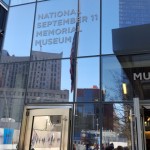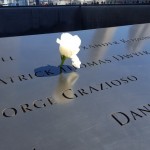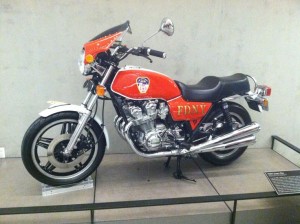Note: I am publishing this post from 2016 in honor of the 20th anniversary of 9/11.
By Suzanne Sparrow Watson
 There is a quietness about the September 11th Memorial and Museum. Visitors appear to be lost in thought as we wait for the doors to open. Trepidation is etched on everyone’s face – do we really want to re-live that horrible day? And yet we all file in, bracing ourselves for what we know will be a difficult and emotional visit. The museum offers three options for viewing the exhibits; we chose a guided tour led by one of the volunteers. Our guide was a young man from New Jersey who lost neighbors in the terrorist attack, so for him, this museum is personal. I reflected that we are fortunate in our generation to be guided by such people; future generations will experience it from a more distant perspective.
There is a quietness about the September 11th Memorial and Museum. Visitors appear to be lost in thought as we wait for the doors to open. Trepidation is etched on everyone’s face – do we really want to re-live that horrible day? And yet we all file in, bracing ourselves for what we know will be a difficult and emotional visit. The museum offers three options for viewing the exhibits; we chose a guided tour led by one of the volunteers. Our guide was a young man from New Jersey who lost neighbors in the terrorist attack, so for him, this museum is personal. I reflected that we are fortunate in our generation to be guided by such people; future generations will experience it from a more distant perspective.
Our guide started the tour at the bottom of the museum, in Foundation Hall, where the famous “slurry wall” stands. When the Trade Center was built in the mid-1960’s, the slurry wall held back the Hudson River, which lapped at the side of the building. After the attack on 9/11, when the site was being excavated, the workers were astounded to find that the slurry wall had survived. Daniel Libeskind, the architect who led the redevelopment of the site, pushed to keep a portion of the slurry wall in place. He proclaimed that it was a testament to the determination and resilience of a nation; a document “as eloquent as the Constitution itself”.
Also in Foundation Hall is the “Last Column,” a 36-foot girder that was the last to be removed from the site, marking the end of the recovery effort. During the excavation it quickly became a makeshift memorial, plastered with Mass cards, rosary beads, flags, photos of missing innocents, and patches from fire and police units. When it was finally cut down, it was laid on a flatbed truck, draped in black, with an American flag over it, and escorted by first responder honor guards to a place of safekeeping. It now stands in Foundation Hall as a physical reminder of our resilience and hope.
There are many displays that feature recovered portions of the buildings – bent beams, the only remaining glass window and the “Survivor’s Staircase”, used by many to escape the burning towers. But I suspect that the main reason most of us come to the museum is to pay tribute to the people who were lost that day. After seeing massive beams bent and misshapen by the impact of planes and the heat of the fires, it gives new perspective to what the people trapped in those structures experienced. I recall one of the shell-shocked firemen who survived the collapse of the towers saying, “How bad must it have been up there that people thought jumping out of a window from the 100th floor was the better alternative?”
One particularly poignant display is of the motorcycle that belonged to Gerard Baptiste, a firefighter with Ladder 9 in Lower Manhattan. Two weeks before 9/11 he bought a broken-down 1979 Honda motorcycle off the street for $100. It wouldn’t start so he had to roll it to the firehouse. The guys ribbed him endlessly about buying a worthless piece of junk. Baptiste died at the Trade Center and shortly afterward, the surviving members of his firehouse decided to restore the bike in his honor. With the help of Honda, some motorcycle shops and private donors, they were able to transform it into what is now known as “The Dream Bike”. The bike was auctioned, with proceeds donated to the education fund for the children of firefighters from Ladder 9 who were lost on 9/11. The winning raffle ticket, selected by Baptiste’s mother, went to a woman from California who donated the bike to the museum so everyone would know its story.
There is a room called “The Wall of Faces” filled with pictures of the victims. It is hard see their smiling faces, knowing that their lives would end so tragically. They are the faces of people who, on a gloriously sunny Tuesday morning, kissed a loved one good-bye, walked out their front door, and were never seen again. Down the hall from the “Wall of Faces” is an alcove, a small space with black walls and four benches. On each of the four walls is a projection of video remembrances of the victims. Each person who died is remembered with a picture and a bit of personal background information. For most of them there is also an audio remembrance from a family member or friend.
I sat in the video room for a while, as the images and voices streamed past. It was heartbreaking to hear a young woman talk about how much her children miss their dad and a father describe how proud he was of his lost son. One woman remembered her husband through the story of a Thanksgiving dinner when they got into a spat because the gravy was missing from the dinner table. They argued and both stalked off to the kitchen. She said they imagined that all of the relatives thought they were in there fighting but, in fact, they were kissing. She said “that’s just who we were”. Some voices were very emotional as they described their loved one, some sounded wistful, and others like the woman with the gravy story, chose to remember a lighter moment. No matter the emotion, the remembrances brought the victims back to life, and made the violent nature of their death all the more jarring. Our guide told us that if we saw a guide wearing a tan vest, that person is a family member of a victim. Some of them come every day as a way to work through their grief and talk about their loved one.
I should note that there is a small portion of the museum that describes the rise of Al Qaeda and the planning of the 9/11 attacks. There are photos of Osama bin Laden and the 19 hijackers, along with a video description of how they carried out their plot. The photos of the hijackers are placed very low on the wall, much below eye level, so you can easily walk past them without having to look at their faces. After what I seen prior to that exhibit, my instinct was to give those pictures a swift kick. I questioned why we had to acknowledge them at all in a place of reverence and dedication. But on further reflection, I realized what the museum designers intended – future generations will not recall the events of 9/11 from personal experience, they will need to learn about it from history books and places like the September 11th museum. So the “who”, “why” and “how” need to be included to present a complete picture.
 We finished our tour of the museum and went outside to visit the memorial plaza and the two reflecting pools, where the names of the victims are carved into the steel that surrounds them. The pools are built on the former foundations of the two towers and are symbolic of the sadness one feels there. One person has described the water cascading over the four sides of the pools as the endless tears shed over the victims. Perhaps the most touching site I saw all day was the single white roses stuck sporadically into the carvings of names. I had assumed that family members laid those flowers on the names of their loved one. But in fact, each morning the staff of the museum places a white rose on the name of any victim who would have celebrated a birthday that day. I found that to be such an elegant gesture and thoughtful beyond words.
We finished our tour of the museum and went outside to visit the memorial plaza and the two reflecting pools, where the names of the victims are carved into the steel that surrounds them. The pools are built on the former foundations of the two towers and are symbolic of the sadness one feels there. One person has described the water cascading over the four sides of the pools as the endless tears shed over the victims. Perhaps the most touching site I saw all day was the single white roses stuck sporadically into the carvings of names. I had assumed that family members laid those flowers on the names of their loved one. But in fact, each morning the staff of the museum places a white rose on the name of any victim who would have celebrated a birthday that day. I found that to be such an elegant gesture and thoughtful beyond words. We left the museum and went for a very long walk back to our hotel, reflecting on the gamut of emotions we experienced on the tour. I picked up a copy of USA Today in the lobby; the front page headline blared “US Military Families to Evacuate Turkey” due to possible attacks. Sadly, the beat goes on. But thankfully, so do we. The new One World Trade Center, also known as the Freedom Tower, is now complete and other buildings are going up where once the ground was but a scar. Would I recommend going to the 9/11 Museum? I guess that depends on your perspective. One of the guest services workers at our hotel said he couldn’t go – that it is still too soon. For me, it was well worth the visit; it is a place where we can reflect, mourn and vow to move forward.
We left the museum and went for a very long walk back to our hotel, reflecting on the gamut of emotions we experienced on the tour. I picked up a copy of USA Today in the lobby; the front page headline blared “US Military Families to Evacuate Turkey” due to possible attacks. Sadly, the beat goes on. But thankfully, so do we. The new One World Trade Center, also known as the Freedom Tower, is now complete and other buildings are going up where once the ground was but a scar. Would I recommend going to the 9/11 Museum? I guess that depends on your perspective. One of the guest services workers at our hotel said he couldn’t go – that it is still too soon. For me, it was well worth the visit; it is a place where we can reflect, mourn and vow to move forward.


Thank you. Well done as always. I look forward to a visit there but feel better prepared after your sensitive and thoughtful observations.
A terrible event we will never forget but the kind and thoughtful gestures you describe go a long way toward healing and redemption. Last time I saw the site it was bare and very erie. This is better.
Keep up the good work. You are a treasure!
Thank you, Fran. That is quite a compliment coming from you. It really is a magnificent structure and they have presented the artifacts in a thoughtful way. I’m sure you will appreciate it when you see it.
Beautiful and thoughtful, Suzanne. It’s always been too soon for me to visit, but now feels like the right time. Thank you!
I think you would appreciate it, Janet. It’s really well done and well worth your time next time you’re in NYC.